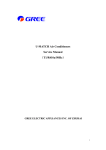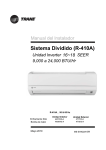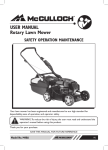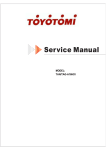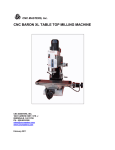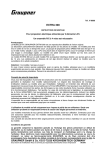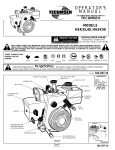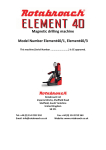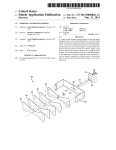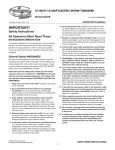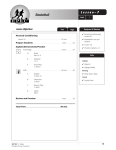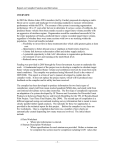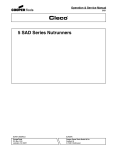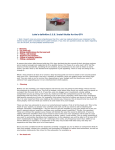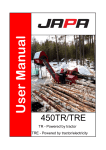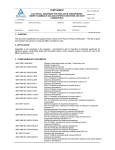Download PDST24/PDST32 GASOLINE SNOW THROWER
Transcript
PDST24/PDST32 GASOLINE SNOW THROWER Owner's Manual 1-888-807-6660 American SD Power Inc This manual provides information regarding the operation and maintenance of these products. We have made every effort to ensure the accuracy of the information in this manual. We reserve the right to change this product at any time without prior notice. Please keep this manual available to all users during the entire life of the snow thrower. TABLE OF CONTENTS 1. Important Safe Operation Practices...............................................................3 2. Assembling Your Snow Thrower ...................................................................6 3. Know Your Snow Thrower ..........................................................................6 4. Operating Your Snow Thrower ......................................................................10 5. Making Adjustments ......................................................................................13 6. Maintaining Your Snow Thrower....................................................................15 7. Servicing Your Snow Thrower........................................................................15 8. Troubleshooting........................................... ..... .......... .................................20 9. Illustrated Parts List .................................. ....................................................22 2 SECTION 1: IMPORTANT SAFE OPERATION PRACTICES WARNING: Engine Exhaust, some of its constituents, and certain vehicle components contain or emit chemicals known to the State of California to cause cancer, birth defects or other reproductive harm. DANGER: This machine was built to be operated according to the rules for safe operation in this manual. As with any type of power equipment, carelessness or error on the part of the operator can result in serious injury. This machine is capable of amputating hands and feet and throwing objects. Failure to observe the following safety instructions could result in serious injury or death. DANGER: This machine was built to be operated according to the rules for safe operation in this manual. As with any type of power equipment, carelessness or error on the part of the operator can result in serious injury. This machine is capable of amputating hands and feet and throwing objects. Failure to observe the following safety instructions could result in serious injury or death. Training 4. Use a grounded three-wire extension cord and receptacle for all units with electric start engines. 5. Adjust collector housing height to clear gravel or crushed rock surfaces. 1. Read, understand, and follow all instructions on the machine and in the manual(s) before attempting to assemble and operate. Keep this manual in a safe place for future and regular reference and for ordering replacement parts. 2. Be familiar with all controls and their proper operation. Know how to stop the machine and disengage them quickly. 3. Never allow children under 14 years old to operate this machine. Children 14 years old and over should read and understand the operation instructions and safety rules in this manual and should be trained and supervised by a parent. 4. Never allow adults to operate this machine without proper instruction. 5. Thrown objects can cause serious personal injury. Plan your snow-throwing pattern to avoid discharge of material toward roads, bystanders and the like. 6. Keep bystanders, helpers, pets and children at least 75 feet from the machine while it is in operation. Stop machine if anyone enters the area. 7. Exercise caution to avoid slipping or falling, especially when operating in reverse. 6. Disengage all control levers before starting the engine. 7. Never attempt to make any adjustments while engine is running, except where specifically recommended in the operator’s manual. 8. Let engine and machine adjust to outdoor temperature before starting to clear snow. 9. To avoid personal injury or property damage use extreme care in handling gasoline. Gasoline is extremely flammable and the vapors are explosive. Serious personal injury can occur when gasoline is spilled on yourself or your clothes, which can ignite. Wash your skin and change clothes immediately. a. Use only an approved gasoline container. b. Extinguish all cigarettes, cigars, pipes and other sources of ignition. c. Never fuel machine indoors. d. Never remove gas cap or add fuel while the engine is hot or running. e. Allow engine to cool at least two minutes before refueling. f. Never over fill fuel tank. Fill tank to no more than ½ inch below bottom of filler neck to provide space for fuel expansion. g. Replace gasoline cap and tighten securely. h. If gasoline is spilled, wipe it off the engine and equipment. Move machine to another area. Wait 5 minutes before starting the engine. i. Never store the machine or fuel container inside where there is an open flame, spark or pilot light (e.g. furnace, water heater, space heater, clothes dryer etc.). j. Allow machine to cool at least 5 minutes before storing. Preparation 1. Thoroughly inspect the area where the equipment is to be used. Remove all doormats, newspapers, sleds, boards, wires and other foreign objects, which could be tripped over or thrown by the auger/ impeller. 2. Always wear safety glasses or eye shields during operation and while performing an adjustment or repair to protect your eyes. Thrown objects which ricochet can cause serious injury to the eyes. 3. Do not operate without wearing adequate winter outer garments. Do not wear jewelry, long scarves or other loose clothing, which could become entangled in moving parts. Wear footwear which will improve footing on slippery surfaces. 3 Operation 18. Never put your hand in the discharge or collector openings. Always use the clean-out tool provided to unclog the discharge opening. Do not unclog chute assembly while engine is running. Shut off engine and remain behind handles until all moving parts have stopped before unclogging. 19. Use only attachments and accessories approved by the manufacturer (e.g. wheel weights, tire chains, cabs etc.). 20. If situations occur which are not covered in this manual, use care and good judgment. Contact your dealer. 1. Do not put hands or feet near rotating parts, in the auger/impeller housing or chute assembly. Contact with the rotating parts can amputate hands and feet. 2. The auger/impeller control lever is a safety device. Never bypass its operation. Doing so makes the machine unsafe and may cause personal injury. 3. The control levers must operate easily in both directions and automatically return to the disengaged position when released. 4. Never operate with a missing or damaged chute assembly. Keep all safety devices in place and working. 5. Never run an engine indoors or in a poorly ventilated area. Engine exhaust contains carbon monoxide, an odorless and deadly gas. 6. Do not operate machine while under the influence of alcohol or drugs. 7. Muffler and engine become hot and can cause a burn. Do not touch. 8. Exercise extreme caution when operating on or crossing gravel surfaces. Stay alert for hidden hazards or traffic. 9. Exercise caution when changing direction and while operating on slopes. 10. Plan your snow-throwing pattern to avoid discharge towards windows, walls, cars etc. Thus, avoiding possible property damage or personal injury caused by a ricochet. 11. Never direct discharge at children, bystanders and pets or allow anyone in front of the machine. 12. Do not overload machine capacity by attempting to clear snow at too fast of a rate. 13. Never operate this machine without good visibility or light. Always be sure of your footing and keep a firm hold on the handles. Walk, never run. 14. Disengage power to the auger/impeller when transporting or not in use. 15. Never operate machine at high transport speeds on slippery surfaces. Look down and behind and use care when backing up. 16. If the machine should start to vibrate abnormally, stop the engine, disconnect the spark plug wire and ground it against the engine. Inspect thoroughly for damage. Repair any damage before starting and operating. 17. Disengage all control levers and stop engine before you leave the operating position (behind the handles). Wait until the auger/impeller comes to a complete stop before unclogging the chute assembly, making any adjustments, or inspections. Maintenance & Storage 1. Never tamper with safety devices. Check their proper operation regularly. Refer to the maintenance and adjustment sections of this manual. 2. Before cleaning, repairing, or inspecting machine disengage all control levers and stop the engine. Wait until the auger/impeller come to a complete stop. Disconnect the spark plug wire and ground against the engine to prevent unintended starting. 3. Check bolts and screws for proper tightness at frequent intervals to keep the machine in safe working condition. Also, visually inspect machine for any damage. 4. Do not change the engine governor setting or overspeed the engine. The governor controls the maximum safe operating speed of the engine. 5. Snow thrower shave plates and skid shoes are subject to wear and damage. For your safety protection, frequently check all components and replace with original equipment manufacturer’s (OEM) parts only. “Use of parts which do not meet the original equipment specifications may lead to improper performance and compromise safety!” 6. Check controls periodically to verify they engage and disengage properly and adjust, if necessary. Refer to the adjustment section in this operator’s manual for instructions. 7. Maintain or replace safety and instruction labels, as necessary. 8. Observe proper disposal laws and regulations for gas, oil, etc. to protect the environment. 9. Prior to storing, run machine a few minutes to clear snow from machine and prevent freeze up of auger/ impeller. 10. Never store the machine or fuel container inside where there is an open flame, spark or pilot light such as a water heater, furnace, clothes dryer etc. 11. Always refer to the operator’s manual for proper instructions on off-season storage. 4 YOUR RESPONSIBILITY Restrict the use of this power machine to persons who read, understand and follow the warnings and instructions in this manual and on the machine. Do not modify engine Notice regarding Emissions To avoid serious injury or death, do not modify engine in any way. Tampering with the governor setting can lead to a runaway engine and cause it to operate at unsafe speeds. Never tamper with factory setting of engine governor. Engines which are certified to comply with California and federal EPA emission regulations for SORE (Small Off Road Equipment) are certified to operate on regular unleaded gasoline, and may include the following emission control systems: Engine Modification (EM) and Three Way Catalyst (TWC) if so equipped. SAFETY LABELS FOUND ON YOUR SNOW THROWER DANGER DANGER 1. KEEP AWAY FROM ROTATING IMPELLER AND AUGER. CONTACT WITH IMPELLER OR AUGER CAN AMPUTATE HANDS AND FEET. 2. USE CLEAN-OUT TOOL TO UNCLOG DISCHARGE CHUTE. 3. DISENGAGE CLUTCH LEVERS, STOP ENGINE, AND REMAIN BEHIND HANDLES UNTIL ALL MOVING PARTS HAVE STOPPED BEFORE UNCLOGGING OR SERVICING MACHINE. 4. TO AVOID THROWN OBJECTS INJURIES, NEVER DIRECT DISCHARGE AT BYSTANDERS. USE EXTRA CAUTION WHEN OPERATING ON GRAVEL SURFACES. 5. READ OPERATOR'S MANUAL. CLEAN-OUT TOOL DANGER AVOID INJURY FROM ROTATING AUGER KEEP HANDS, FEET AND CLOTHING AWAY. 5 NEVER PUT HAND IN CHUTE. CONTACT WITH ROTATING PARTS CAN AMPUTATE FINGERS AND HANDS. SHUT OFF ENGINE AND WAIT UNTIL ALL MOVING PARTS HAVE STOPPED BEFORE UNCLOGGING. USE CLEAN-OUT TOOL OR WOODEN STICK TO UNCLOG DISCHARGE CHUTE. SECTION 2: ASSEMBLING YOUR SNOW THROWER 2 1 3 NOTE: References to right or left side of the snow thrower are determined from behind the unit in the operating position (standing directly behind the snow thrower, facing the handle panel). NOTE: This Operator’s Manual covers several models. Snow thrower features vary by model. Not all features referenced and pictured in this manual are applicable to all snow thrower models. CAUTION: Prior to operating your snow thrower, refer to Auger Control Test. Read and follow all instructions carefully and perform all adjustments to verify your snow thrower is operating safely and properly. Securing the Handle Based on the strength of the travelling cable, insert the travelling cable and snow throwing cable to the proper plugs, and check if machine works properly. 6 Attaching the Chute Assembly and Directional Control 1. Install the chute to the correct holes of outer shell's back. 2. Use the bolt and nut to fix the chute and bearing to the support base of chute. 3. After install the chute direction control,then make it drill through rotary shaft,let the chute direction control istall to the chute.Use nut to fix the chute direction control to the chute,and istall one gasket to the chute raised step. Install the plum-plastic-head bolt,locked equipment 4. bush,locked equipment stress blockand spring to the throwing snow-rotating-shaft. Screw down the plumplastic-head bolt,make the locked equipment stress block and regulating-rod of chute tightness combined, and press the throwing snow-rotating-shaft. NOTE: If necessary, the lower bracket can be adjusted. Refer to Chute Bracket Adjustment CAUTION: Prior to operating your snow thrower, refer to Auger Control Test Read and follow all instructions carefully and perform all adjustments to verify your snow thrower is operating safely and properly. Tire Pressure • Before operating, check tire pressure and reduce pressure in both tires to between 15 psi and 20 psi. NOTE: If the tire pressure is not equal in both tires, the unit may not travel in a straight path and the shave plate may wear unevenly. NOTE:The detailed instruction is attached in User's Manual. 7 SECTION 3: KNOW YOUR SNOW THROWER Shift Lever Drive Control Gas Cap Auger Control Chute Assembly Chute Directional Control Clean-out Tool Oil Fill Skid Shoe Augers Choke Control WARNING: Read, understand, and follow all instructions and warnings on the machine and in this manual before operating. NOTE: For detailed starting instructions and more CHOKE LEVER Closed information on all engine controls, refer to the Engines manual packed separately and Starting The Engine on this manual. Opend OPEN CLOSED Closed The choke control is found on the rear of the engine and is activated by rotating the knob clockwise. Activating the choke control closes the choke plate on the carburetor and aids in starting the engine. Shift Lever Throttle Control The shift lever is located in the center of the handle panel. Place the shift lever into any of eight positions to control the direction of travel and ground speed. Forward There are six forward (F) speeds. Position one (1) is the slowest and position six (6) is the fastest. M IN. Reverse MAX. There are two reverse (R) speeds. One (1) is the slower and two (2) is the faster. The throttle controlis located on the engine. It regulates the speed of the engine Gas Cap Unthread the gas cap to add gasoline to the fuel tank. Primer Oil Fill Engine oil level can be checked and oil added through the oil fill. MIN. THROTTLE LEVER 8 Depressing the primer forces fuel directly into the engine’s carburetor to aid in cold-weather starting. Auger Control Fuel Valve Lever Fuel valve- Allows fuel to enter engine. AUGER CONTROL FUEL VALVE LEVER ON ON GO OFF Clean-Out Tool WARNING: Never use your hands to clear The auger control is located on the left handle. Squeeze the control grip against the handle to engage the augers and start snow throwing action. Release to stop. a clogged chute assembly. Shut off engine and remain behind handles until all moving parts have stopped before unclogging. Drive Control DRIVE CONTROL The chute clean-out tool is fastened to the top of the auger housing with a mounting clip. The tool is designed to clear a clogged chute assembly. Refer to Operating Your Snow Thrower section for more detailed information regarding the chute clean-out tool. NOTE: This item is fastened with a cable tie to the rear of the auger housing at the factory. Cut the cable tie before operating the snow thrower. Skid Shoes Position the skid shoes based on surface conditions. Adjust upward for hard-packed snow. Adjust downward when operating on gravel or crushed rock surfaces. GO Recoil Starter Handle The drive control is located on the right handle. Squeeze the control grip against the handle to engage the wheel drive. Release to stop. The recoil starter handle is used to manually start the engine. Electric Starter Button Chute Directional Control (If so equipped) Pressing the electric starter button engages the engine’s electric starter when plugged into a 120V power source. CHUTE DIRECTIONAL CONTROL DISCHARGE LEFT DISCHARGE RIGHT ADJUSTABLE CHUTE TILT Electric Starter Outlet (If so equipped) Requires use of a three-prong outdoor extension cord (packed with the snow thrower) and a 120V power source/wall outlet. TO STARTER • SWITCHCORD SWITCHBOX STARTER BUTTON Regulate the plum-plastic-head nut to the rightside of the direction cover,can regulate the height of direction cover through loosing nut. POWERCORD To adjust the chute in the middle, push the shaft toward north and them turn left(See diagram 1) if more the shaft toward northwest, the chute will turn to the right. Augers Chute Assembly When engaged, the augers rotate and draw snow into the housing. • Snow drawn into the auger housing is discharged out the chute assembly. TO OUTLET 9 120V A.C. APPLICATION SECTION 4: OPERATING YOUR SNOW THROWER WARNING: If your home electrical Before Starting system is grounded, but a three-hole receptacle is not available, do not use your snow thrower’s electric starter. WARNING: Read, understand, and follow all instructions and warnings on the machine and in this manual before operating. If you have a grounded three-prong receptacle, proceed as follows: • Gas & Oil Fill-Up Service the engine with gasoline and oil as instructed in the Engines manual packed separately with your snow thrower. Read instructions carefully. • WARNING: Use extreme care when NOTE: If the engine is already warm, place choke handling gasoline. Gasoline is extremely flammable and the vapors are explosive. Never fuel the machine indoors or while the engine is hot or running. Extinguish cigarettes, cigars, pipes and other sources of ignition. • control in the OPEND position instead of CLOSED. • A small plastic cup may be located inside the fuel fill opening beneath the gas cap. Remove and discard this cup before filling up the tank. • • • Push the primer two or three times for cold engine start, making sure to cover vent hole in the center of the primer when pushing. NOTE: DO NOT use primer to restart a warm engine after a short shutdown. • • Starting The Engine • Plug the extension cord into the outlet located on the engine’s surface. Plug the other end of extension cord into a three-prong 120-volt, grounded, AC outlet in a well-ventilated area. Rotate choke control to CLOSED choke position (cold engine start). Attach spark plug wire to spark plug. Make certain the metal loop on the end of the spark plug wire (inside the boot) is fastened securely over the metal tip on the spark plug. Make certain both the auger control and drive control are in the disengaged (released) position. Move throttle control up to MAX. position. Insert ignition key into slot. Make sure it snaps into place. Do not attempt to turn the key. Move the fuel valve lever to the ON position. • • Push starter button to start engine. Once the engine starts, immediately release starter button. As the engine warms, slowly rotate the choke control to the OPEND position. If the engine falters, quickly rotate the choke control back to CLOSED and then slowly into the OPEND position again. When disconnecting the extension cord, always unplug the end at the three-prong wall outlet before unplugging the opposite end from the snow thrower. Recoil Starter • NOTE: The engine cannot start unless the key is inserted into ignition switch. Rotate choke control to CLOSED choke position (cold engine start). Electric Starter (on models so quipped) NOTE: If the engine is already warm, place choke • control in the OPEND position instead of CLOSED. Determine that your home’s wiring is a three-wire grounded system. Ask a licensed electrician if you are not certain. • Push the primer two or three times for cold engine start, making sure to cover vent hole in the center of the primer when pushing. CAUTION: If your home’s wiring system is not a three-wire grounded system, do not use this electric starter under any conditions. NOTE: DO NOT use primer to restart a warm engine WARNING: The optional electric starter is temperature is below 15° Fahrenheit. after a short shutdown. NOTE: Additional priming may be necessary if the equipped with a grounded three-wire power cord and plug, and is designed to operate on 120 volt AC household current. It must be used with a properly grounded three-prong receptacle at all times to avoid the possibility of electric shock. Follow all instructions carefully prior to operating the electric starter. • 10 Grasp the recoil starter handle and slowly pull the rope out. At the point where it becomes slightly harder to pull the rope, slowly allow the rope to recoil. • To Engage Drive Pull the starter handle with a firm, rapid stroke. IMPORTANT: Do not release the handle and allow it to • snap back. Keep a firm hold on the starter handle and allow it to slowly recoil. • As the engine warms, slowly rotate the choke control to the OPEND position. If the engine falters, quickly rotate the choke control back to the CLOSEDposition and then slowly into the OPEND position again. IMPORTANT: Use the slower speeds until you are comfortable and familiar with the operation of the snow thrower. Stopping The Engine • • • Run engine for a few minutes before stopping to help dry off any moisture on the engine. To help prevent possible starter freeze-up, proceed as follows: • Electric Starter (on models so equipped) 1. 2. 3. 4. 5. 6. 7. With the throttle control in the Fast (rabbit) position, move shift lever into one of the six forward (F) positions or two reverse (R) positions. Select a speed appropriate for the snow conditions and a pace you’re comfortable with. Connect extension cord to the electric starter outlet on the engine, then to 120 volt AC outlet. With the engine running, push the starter button and allow the starter for spin for several seconds. The noise made by the starter is normal. The engine’s starter is not being harmed. When disconnecting the extension cord, always unplug the end at the three-prong wall outlet before unplugging the opposite end from the snow thrower. Move throttle control to MIN position. Turn the fuel valve lever tothe OFF position. Remove the ignition key. Wipe all snow and moisture from the carburetor cover in the area of the drive control and auger control. Also, engage and release the controls several times. Squeeze the auger control against the handle and the augers will turn. Release it and the augers will stop. Squeeze the drive control against the handle the snow thrower will move. Release it and drive motion will stop. IMPORTANT: NEVER reposition the shift lever (change speeds or direction of travel) without first releasing the drive control and bringing the snow thrower to a complete stop. Doing so will result in premature wear to the snow thrower’s drive system. To Engage Augers • To engage the augers and start throwing snow, squeeze the auger control against the left handle. Release to stop the augers. Auger Control Test IMPORTANT: Perform the following test before operating your snow thrower for the first time and at the start of each winter season. NOTE: Keep the key in a safe place. The engine Check the adjustment of the auger control as follows: cannot start without the ignition key. • Recoil Starter 1. With engine running, pull starter rope with a rapid, continuous full arm stroke three or four times. Pulling the starter rope will produce a loud clattering sound, which is not harmful to engine. 2. Move throttle control to MIN position. 3. Remove the ignition key. 4. Turn the fuel valve lever tothe OFF position. 5. Wipe all snow and moisture from the carburetor cover in the area of the drive control and auger control. Also, engage and release the controls several times. • • • • • When the auger control is released and in the disengaged “up” position, the cable should have very little slack. It should NOT be tight. In a well-ventilated area, start the snow thrower engine as instructed earlier in this section under the heading Starting the Engine. Make sure the throttle is set in the FAST position. While standing in the operator’s position (behind the snow thrower), engage the auger. Allow the auger to remain engaged for approximately ten (10) seconds before releasing the auger control. Repeat this several times. With the throttle control in the FAST (rabbit) position and the auger control in the disengaged “up” position, walk to the front of the machine. Confirm that the auger has completely stopped rotating and shows NO signs of motion. IMPORTANT: If the auger shows ANY signs of rotating, immediately return to the operator’s position and shut off the engine. Wait for ALL moving parts to stop before re-adjusting the auger control. 11 Chute Clean-Out Tool Tire Chains (on models so equipped) The chute clean-out tool is conveniently fastened to the rear of the auger housing with a mounting clip. Should snow and ice become lodged in the chute assembly during operation, proceed as follows to safely clean the chute assembly and chute opening: Tire chains should be used whenever extra traction is needed. If your unit is not equipped with tire chains, contact Customer Support as instructed for information regarding price and availability. • • • • Operating Tips Release both the Auger Control and the Drive Control. Stop the engine by removing the ignition key. Remove the clean-out tool from the clip which secures it to the rear of the auger housing. Use the shovel-shaped end of the clean-out tool to dislodge and scoop any snow and ice which has formed in and near the chute assembly. NOTE: Allow the engine to warm up for a few minutes after starting. The engine will not develop full power until it reaches operating temperature. WARNING: The muffler, engine and surrounding areas become hot and can cause a burn. Do not touch. WARNING: Never use your hands to clean • • • snow and ice from the chute assembly or auger housing • • Refasten the clean-out tool to the mounting clip on the rear of the auger housing, reinsert the ignition key and start the snow thrower’s engine. While standing in the operator’s position (behind the snow thrower), engage the auger control for a few seconds to clear any remaining snow and ice from the chute assembly. • Discharge snow downwind whenever possible. Slightly overlap each previous swath. Set the skid shoes 1/4” below the scraper bar for normal usage. The skid shoes may be adjusted upward for hard-packed snow. Adjust downward when using on gravel or crushed rock. Avoid possible starter freeze-up. Clean the snow thrower thoroughly after each use. NOTE: It will damage the belt if snow thrower is working in the idle sitation for a while. Drift Cutters(on models so equipped) Drift cutters should be used when operating the snow thrower in heavy drift conditions. On models so equipped, drift cutters are assembled to the auger housing inverted. Remove the carriage bolts by unthreading the hex nuts which secure them, and reinstall the drift cutters in their proper position before operating the snow thrower. See Figure 2. Drift Cutter Carriage Screws / Hex Nuts Figure 2 If your unit is not equipped with drift cutters, contact Customer Support as instructed for information regarding price and availability. 12 SECTION 5: MAKING ADJUSTMENTS WARNING: Never attempt to make any adjustments while the engine is running, except where specified in operator’s manual. 1 Shift Cable Adjustment If the full range of speeds (forward and reverse) cannot be achieved, refer to the figures to the right and adjust the shift rod as follows: 1. Rotate the shift arm clockwise as far as it will go. 2. Thread the ferrule up or down the shift rod until it aligns with the hole in the shift lever behind the handle panel. Regulate the speed through the 3 holes' position of the regulating piece.When the regulating cable connect with the first hole,the walking speed is fastest.connect with the second hole,the walking speed is more slowly. connect with the third hole,the walking speed is the most slowly. Tire Pressure • 2 Before operating, check tire pressure and reduce pressure to between 15 psi and 20 psi. NOTE: If the tire pressure is not equal in both tires, the unit may pull to one side or the other. Chute Assembly The distance snow is thrown can be adjusted by changing the angle of the chute assembly. To do so, stop the engine by removing the ignition key and loosen the plastic wing knob found on the left side of the chute assembly. Pivot the chute upward or downward before re-tightening the wing knob. See Figure 3. Figure 3 13 Drive Control When the drive control is released and in the disengaged “up” position, the cable should have very little slack. It should NOT be tight. Check the adjustment of the drive control as follows: 1. With the drive control released, push the snow thrower gently forward. The unit should roll freely. 2. Engage the drive control and gently attempt to push the snow thrower forward. The wheels should not turn. The unit should not roll freely. 3. With the drive control released, move the shift lever back and forth between the R2 position and the F6 position several times. There should be no resistance in the shift lever. Auger Control Refer to Auger Control Test on Page 11 to adjust the auger control. Skid Shoes The space between the skid shoes and the ground can be adjusted. See Figure 5. • • For close snow removal on a smooth surface, raise skid shoes higher on the auger housing. Use a middle or lower position when the area to be cleared is uneven, such as a gravel driveway. CAUTION: Loose gravel can be picked up and thrown by the auger, causing injury to the operator and bystanders and/or damage to the snow thrower and surrounding property. • • Adjust skid shoes by loosening the four hex nuts (two on each side) and carriage bolts. Move skid shoes to desired position. Make certain the entire bottom surface of skid shoe is against the ground to avoid uneven wear on the skid shoes. Retighten nuts and bolts securely. Figure 5 14 SECTION 6: MAINTAINING AND SERVICING YOUR SNOW THROWER Auger Shaft WARNING: Before lubricating, repairing, or inspecting, disengage all controls and stop engine. Wait until all moving parts have come to a complete stop. • At least once a season, remove the shear pins on auger shaft. Spray lubricant inside shaft, around the spacers. Also lubricate the flange bearings found at either end of the shaft. See Figure 8. Engine Refer to the separate POWERLAND Engines manual packed with your unit for all engine maintenance. Bearing Spacers Bearing Lubrication Engine Refer to the separate POWERLAND ngines manual packed with your unit for all engine lubrication instructions. Gear Shaft The gear (hex) shaft should be lubricated at least once a season or after every 25 hours of operation. • • Remove the lower frame cover by removing the two screws which secure it. Apply a light coating of an all-weather multipurpose grease to the hex shaft. See Figure 7. Shear Pins Shear Pins NOTE: 30-inch Auger Shown Figure 8 Gear Case The auger gear case has been filled with grease at the factory. If disassembled for any reason, lubricate with two ounces of grease (Part Number 737-0168). IMPORTANT: Do not overfill the gear case. Damage to the seals could result. Be sure the vent plug is free of grease in order to relieve pressure. WARNING: Before servicing, repairing, or inspecting, disengage all controls and stop engine. Wait until all moving parts have come to a complete stop. Shave Plate and Skid Shoes • Figure 7 IMPORTANT: Keep lubricant off the friction wheel and • drive plate. Wheels • At least once a season, remove both wheels. Clean and coat the axles with a multipurpose automotive grease before reinstalling wheels. • Chute Directional Control • Once a season, the spiral end on the chute directional control should be greased with multipurpose automotive grease. 15 The shave plate and skid shoes on the bottom of the snow thrower are subject to wear. They should be checked periodically and replaced when necessary. To remove skid shoes, remove the four carriage bolts and hex flange nuts which secure them to the snow thrower. Reassemble new skid shoes with the four carriage bolts (two on each side) and hex flange nuts. Refer to Figure 5. To remove shave plate, remove the carriage bolts and hex nuts which attach it to the snow thrower housing. Reassemble new shave plate, making sure heads of carriage bolts are to the inside of housing. Tighten securely. Auger Belt Replacement To remove and replace your snow thrower’s auger belt, proceed as follows: 1. Remove the plastic belt cover on the front of the engine by removing the two self-tapping screws. • Drain the gasoline from the snow thrower, or place a piece of plastic under the gas cap. • Carefully pivot the snow thrower up and forward so that it rests on the auger housing. 2. Remove the frame cover from the underside of the snow thrower by removing four self-tapping screws which secure it. 3. Roll the auger belt off the engine pulley. 4. Unhook the support bracket spring from the frame. • Loosen and remove the shoulder screw which acts as a belt keeper. • Remove the belt from around the auger pulley, and slip the belt between the support bracket and the auger pulley • Reassemble auger belt by following instructions in reverse order. IMPORTANT: Do NOT forget to reinstall the shoulder screw and reconnect the spring to the frame after installing a replacement auger belt. 16 Drive Belt Replacement To remove and replace your snow thrower’s auger belt, proceed as follows: 1. Remove the plastic belt cover on the front of the engine by removing the two self-tapping screws. • Drain the gasoline from the snow thrower, or place a piece of plastic under the gas cap. • Carefully pivot the snow thrower up and forward so that it rests on the auger housing. 2. Remove the frame cover from the underside of the snow thrower by removing four self-tapping screws which secure it. 3. a. Grasp the idler pulley and pivot it toward the right. b. Insert a screw driver through aligning holes in both the idler bracket and the engine. c. Roll the auger belt off the engine pulley. d. Lift the drive belt off engine pulley. 4. Slip the drive belt off the pulley and between friction wheel and friction wheel disc. • Remove and replace belt in the reverse order. d c b a 17 Friction Wheel Removal 1 If the snow thrower fails to drive with the drive control engaged, and performing the drive control cable adjustment on page 14 fails to correct the problem, the friction wheel may need to be replaced. Follow the instructions below. Examine the friction wheel for signs of wear or cracking and replace if necessary • • Place the shift lever in third Forward (F3) position. Drain the gasoline from the snow thrower, or place a piece of plastic under the gas cap. • Carefully pivot the snow thrower up and forward so that it rests on the auger housing. 1. a. Remove the frame cover from the underside of the snow thrower by removing four selftapping screws which secure it. b. Remove the right-hand wheel by removing the screw and bell washer which secure it to the axle. c. Locate the hex shaft and E-ring on the right side of the snow thrower frame, about two inches from the wheel axle. c. Using a suitable tool, carefully remove the outer E-ring which secures the hex shaft to the snow thrower frame and lightly tap the shaft’s end to dislodge the ball bearing from the right side of the frame. 2. a. Slide the hex shaft downward and to the left while carefully un-meshing the lower gears on the hex shaft from the upper gears on the wheel axle. b. Set the hex shaft’s gears aside. c. Carefully remove the inner E-ring from the hex shaft and slide the friction wheel assembly off the hex shaft. 2 NOTE: If you’re replacing the friction wheel assembly as a whole, discard the worn part and slide the new part onto the hex shaft. Follow the steps above in reverse order to reassemble components. If you’re disassembling the friction wheel and replacing only the rubber ring, proceed as follows: 3 3. Remove the four screws which secure the friction wheel’s side plates together. • Remove the rubber ring from between the plates. • Reassemble the side plates with a replacement rubber ring. IMPORTANT: Tighten each screw only one rotation before turning the wheel clockwise and proceeding with the next screw. Repeat this process several times to ensure the plates are secured with equal force. • Slide the friction wheel assembly back onto the hex shaft and follow the steps above in reverse order to reassemble components. 18 Augers • • IMPORTANT: NEVER replace the auger shear pins with anything other than OEM Part No.738-04124 replacement shear pins. Any damage to the auger gearbox or other components as a result of failing to do so will NOT be covered by your snow thrower’s warranty. The augers are secured to the spiral shaft with four shear pins and cotter pins. If the auger should strike a foreign object or ice jam, the snow thrower is designed so that the pins may shear. Refer to Figure 8. If the augers will not turn, check to see if the pins have sheared. One set of replacement shear pins has been provided with the snow thrower. When replacing pins, spray an oil lubricant into shaft before inserting new pins. SECTION 7: OFF-SEASON STORAGE WARNING: Never store the machine or fuel container indoors where there is an open flame, spark or pilot light such as on a water heater, furnace, clothes dryer or other gas appliances. • NOTE: Fuel stabilizers, such as STA-BIL®, are an acceptable alternative in minimizing the formation of fuel gum deposits during storage. Do not drain carburetor if using a fuel stabilizer. WARNING: Drain fuel into an approved container outdoors, away from open flame. Allow engine to cool. Extinguish cigarettes, cigars, pipes, and other sources of ignition prior to draining fuel. Fuel left in engine for extended period deteriorates and will cause serious starting problems. • • Wipe equipment with an oiled rag to prevent rust. Remove spark plug and pour one ounce of engine oil through spark plug hole into cylinder. Cover spark plug hole with rag. Crank engine several times to distribute oil. Replace spark plug. • Follow the lubrication recommendations found in the Maintenance Section. • Always store the snow thrower in a clean, dry area. When storing any type of power equipment in an unventilated or metal storage shed, care should be taken to rust proof the equipment. Using a light oil or silicone, coat the equipment, especially any chains, springs, bearings and cables. If unit is to be stored over 30 days, prepare for storage as follows: • • Drain carburetor by pressing upward on bowl drain, located below the carburetor cover. Remove gasoline from carburetor and fuel tank to prevent gum deposits from forming on these parts and causing possible malfunction of engine. Run engine until fuel tank is empty and engine stops due to lack of fuel. 19 SECTION 8: TROUBLE SHOOTING GUIDE Trouble Possible Cause(s) Corrective Action Engine fails to start Fuel tank empty, or stale fuel. Fill tank with clean, fresh gasoline. Fuel will not last over thirty days unless a fuel stabilizer is used. Clean fuel line. Turn the fuel valve lever to the On position. Clean, adjust gap or replace. Insert key into ignition switch. Connect spark plug wire. Refer to the Tecumseh engine manual or Starting the Engine on page 10 of this manual for instructions on the engine primer. Move choke control to OFF position. Clean fuel line; fill tank with clean fresh gasoline. Fuel will not last over thirty days unless a fuel stabilizer is used. Drain fuel tank. Refill with fresh fuel. Refer to the Tecumseh engine manual. Connect and tighten spark plug wire. Remove ice and snow from cap. Be certain vent hole is clear. Clean following the engine manual. Refer to the Tecumseh engine manual packed with your unit or have carburetor adjusted by an authorized service dealer. Stop engine immediately and disconnect spark plug wire. Tighten all bolts and nuts. Make all necessary repairs. If vibration continues, have unit serviced by an authorized service dealer. Adjust drive control cable. Blocked fuel line. fuel valve not trun ON position Faulty spark plug. Ignition key not present. Spark plug wire disconnected. Engine not primed. Engine runs erratic Loss of power Engine overheats Excessive vibration Unit running on CHOKE. Blocked fuel line or stale fuel. Water or dirt in fuel system. Carburetor out of adjustment. Spark plug wire loose. Gas cap vent hole plugged. Exhaust port plugged. Carburetor not adjusted properly. Loose parts or damaged auger. Unit fails to propel itself Incorrect adjustment of drive control cable. Drive belt loose or damaged. Unit fails to Chute assembly clogged. discharge snow Foreign object lodged in auger. Incorrect adjustment of auger control cable. Drive belt loose or damaged. Replace drive belt. Stop engine immediately. Clean chute assembly and inside of auger housing with chute clean-out tool Stop engine immediately. Remove object from auger. Adjust auger control cable. Replace drive belt. NOTE: For repairs beyond the minor adjustments above, contact your local authorized service dealer. 20 SECTION 9: PARTS LIST 21 1 Washer,Bell,ij20×ij10.5×2 2 Shells PadM10 3. Hex Screw,3/8-16×27 l=44 S=14 4 Screw,Self-tapping5/16-18×19 S=12.5 5 Washer,Bell, 6 Crank Assembly,Chute 7 Nut,Flange Locking Hexagon5/16-18 S=12.5 8. Plastic ball 9. Handle,Lower,Snow 10 Nut,Plum Plastic 11 Bolt,Plum,Plastic 12 Hand,Upper,RH 13 Screw,Carriage,5/16-18×51 dk=18 14 Screw,Self-tapping,1/4-20×20 l=38 S=11 15 Screw,Shoulder,10#-24×34 Dyke=ij9 16 Nut,Hex Look,10#-24 S=9.5 17 Handle,Upper,RH 18 Hand Gel 19 Nut,Flange Locking Hexagon,1/4-20 S=10 20 Handle,Upper,LH 21 Handle,Clutch Look,RH 22 Handle,Clutch Look,LH 23 Hand,Upper,LH 24 Nut,Flange Locking Hexagon,1/4-20 S=10 25 Connecting Block,Stall lines 26 Pin,Cotter,ST10#-14×13 S=8 27 Rubber Plug,Buffer 28 Significant Tailgate 29 Nut,Flange Locking Hexagon,5/16-18 S=12.5 30 Bolt,Shoulder 31 Flat Padij20×ij10.5×2 32 Spring,Compresionij2.7×ij20×20 33 Nut,Flange Lock,5/16-18 S=12.5 34 Lever,Shift,Speed 35 Supporter 36 Rotation Axis 37 Washer,Bellij24×ij13×2 38 Ring E-Type,GB/T894.2 12 39 Locked-Washer,Saddle 40 Spring Compression,ij0.8×ij18.5×17 41 Bushing NOTE: Snow thrower features and components vary by model. NOT all parts listed above and pictured on the previous page are standard equipment. 22 PARTS LIST 23 3. 4. 5. 6. 7. 8. 9. 10. Hex Screw,5/16-24×19 S=12.5 Washer,Bell,ij24×ij8×2 Wheel,Assembly Complete Spacer Friction Disc,Wheel Hex Screw,ij31×ij20×1.6 Friction Disc,Wheel Ring E-Type,GB/T896-1986 15 11 Bearing 6203 RSNRC 3 12 Screw,Self-Tapping,ST1/4-20×16- ij9.40×2.8-ij 13.7×2 S=9.5 13 Screw,self-tapping,1/4-20×26 S=9.5 14 Screw,self-tapping, ST1/4-20×16 S=9.5 15 Wheel,Rubber 16 Guide Bracket, Front, Auger Cable 17. Guide Bracket, Auger Cable 18 Hex Screw,M10X40 19 M10,Washer,Bell, 20 Screw,Self-tapping,ST1/4-20×16 S=9.5 21 Ring E-Type,GB/T896-1986 17 22 Key,Hi-pro 23 Gear Assembly 24 Dribe Shaft,Hex 25 Roller Bracket,Dtive Cable 26 Frame Cover 27 Rod Assembly,Shift 28 Spring,Tensileij1.2×ij10×60 29 Screw,Self-Tapping,ST1/4-20×16 S=9.5 30. Gear Shaft 31 Dynamic Guard 32 33 34 35 36 37. 38 39 40 41 NOTE: Washer,Bell Nut,Hex Look,M8×20 Screw,self-Tapping,5/16-18×19 S=12.5 Washer,Bellij24×ij8×2 Ring E-Type Frame Nut,Hex Look,3/8-16 S=14 Screw,Self-tapping,ST1/4-20×16 S=9.5 Nut,Hex Look,5/8-18 S=21 Spring,Tensileij1.2×ij10×35 42 43 44 45 46. 47 48 49 50 Washer,Bell,ij30×ij16×1.6 Spacer Support Bracket Ass'y,Friction Wheel Spring, Shift, Lever U-Washer,Saddle Nut,Hex Look,5/16-18 S=12.5 Nut,Hex Look,1/4-20 S=10 Regulating-Position Flat Screw,Self-Tapping,ST1/4-20×16-ij9.40×2.8ij13.7×2 S=9.5 51. Screw,Self-Tapping,ST1/4-20×16 S=9.5 52 Nut,Hex Look,M8X25 53 Washer,Bell,ij38×ij8×4 54 Key Flat,8X7×18 55 Pulley,Half 56 Pulley,Auger 57 Spacer 58Key Flat,8X7×14 59 Pulley,Half 60 V-belt 61 Screw,Self-Tapping,3/8-16×27 l=44 S=14 62 Pulley Step Shaft 63. Gasket 64 Bearing,6000-2RS 65 Shell of Bearing 66 Pulley Arm 67 Spring,Reversion,ij2.2×ij27×7 68 Pulley Bush 69 Only Back-chip, Plum 70 Screw,Self-Tapping,ST1/4-20×16-ij9.40×2.8ij13.7×2 S=9.5 71 Gasket 72 Screw,Self-Tapping,ST1/4-20×16 S=9.5 73 Plate,Friction 74 Friction Wheel Rubber 75 Plate,Friction,Extrs 76 Hub,Friction Wheel 77 Ring E-Type,GB/T 894.2 35 78 Bearing Assembly,Friction Wheel 79. Gearing,6000-2RS 80 Pin,Friction Disc Bearing,5/8-18×15-ij30×13 Snow thrower features and components vary by model. NOT all parts listed above and pictured on the previous page are standard equipment. 24 PARTS LIST(ST24) 25 1. Housing, Bearing 2. Bushing, Flange 3. Washer,Bell,ij38×ij19.2×0.8 4. Bushing, Flange 5. Spiral Assembly,LH 6. Spacer 7. Shear Pin 8. Pin ,B-style 9. Washer,Bell,ij38×ij8×4 10. Seal,Oil,Outside 11. Housing.Auger,LH Reduced 12. Seal,Oil 13. Hex Screw, 5/16-24×22 S=12.5 14. Bearing,Flange,Small 15. Washer,Flatij28×ij13×1.5 16. Shaft,Worm 17. Pin,Dowel 18. Collar,Thrust 19. Pulley Assembly 20. Bearing,Flange,Big 21. Nut,Hex Look,5/16-18 S=12.5 22. Washer,Bell,M8 23. Bearing,HK1010 24. Nut,Hex Look,5/16-18×16-ij10×16.5 S=12.6 25. Seal,Oil 26. Sliding Bearing, Knife Shaft 27. Washer,Bell,ij38×ij19.2×0.8 28. Key,Hi-pro 29. Worm 30. Housing,Auger,RH Reduce 31. Cutter Axis NOTE: 32. Bolt,Carriage,5/16-18×13-8×8×4 dk=18 33. Nut,Hex Look,5/16-18 S=12.5 34. Shoe,Slide 35. Nut,Hex Look,3/8-16 S=14 36. Plate,Shave 37. Screw,S elf-Tapping1/4-20×19 S=9.5 38. Impeller Assembly 39. Arm,Tension 40. Mount,Clean Out Tool 41. Clean Out Tool 42. Nut,Flange Lock, Plum 43. Bolt,Carriage5/16-18×51 dk=18 44. Nut,Flange Lock, Non-Metallic Piecesl5/16-18 S=12.5 45. Chute,Lower 46. Chute,Upper 47. Rivetij4x7 48. Plastic Gasket, Chute,Lower 49. Only Back-Chip, Plum 50. Spring,Tensileij1.2×ij10×60 51. Nut,Hex Look,3/8-16×13-ij15.8×4.3 S=24 52. Nut,Hex Look,3/8-16×13-ij15.8×4.3 S=24 53. Nut,Hex Look,3/8-16 S=14 54. Ldler Pulley 55. Bearing,6204ABX-3/3 56. Nut,Hex Look,5/16-18 S=12.5 57. Pulley Adapter 58. Hoursing,Bearing 59. Gasket, Wave-Type,ij23×ij17×0.5 60. Nut,Hex Look,3/8-16×16-ij12.5×8 S=19 61. Nut,Hex Look,3/8-16 S=14 Snow thrower features and components vary by model. NOT all parts listed above and pictured on the previous page are standard equipment. 26 PARTS LIST(ST32) 27 1. Housing, Bearing 2. Bushing, Flange 3. Washer,Bell,ij38×ij19.2×0.8 4. Bushing, Flange 5. Spiral Assembly,LH 6. Spacer,Short 7. Shear Pin 8. Pin ,B-S tyle 9. Spacer,Long 10. Seal,Oil,Outside 11. Housing.Auger,LH Reduced 33. Nut,Hex Look,5/16-18 S=12.5 34. Shoe,Slide 35. Nut,Hex Look,3/8-16 S=14 36. Plate,Shave 37. Screw,Self-Tapping1/4-20×19 S=9.5 38. Impeller Assembly 39. Arm,Tension 40. Mount,Clean Out Tool 41. Clean Out Tool 42. Nut,Flange Lock, Plum 43. Bolt,Carriage,5/16-18×51 dk=18 44. Nut,Flange Lock, Non-Metallic Piecesl5/16-18 S=12.5 45. Chute,Lower 46. Chute,Upper 47. Rivetij4x7 48. Plastic Gasket, Chute,Lower 49. Only Back-C hip, Plum 50. Spring,Tensileij1.2×ij10×60 51. Nut,Hex Look,3/8-16×13-ij15.8×4.3 S=24 52. Nut,Hex Look,3/8-16×13-ij15.8×4.3 S=24 53. Nut,Hex Look,3/8-16 S=14 54. Ldler Pulley 55. Bearing,6204ABX-3/3 56. Nut,Hex Look,5/16-18 S=12.5 57. Pulley Adapter 58. Hoursing,Bearing 59. Gasket, Wave-type,ij23×ij17×0.5 60. Nut,Hex Look,5/16-24×22 S=12.5 61. Washer,Bell,ij38×ij8×4 62. Pulley,Assembly 63. Nut,Hex Look3/8-16×16-ij12.5×8 S=19 64. Nut,Hex Look3/8-16 S=14 12. Hex Screw, 3/8-16×13-ij15.8×4.3 S=24 13. Gasket,Asbestos,M10 14. Bearing,Flange,Small 15. Washer,Flat,ij28×ij13×1.5 16. Shaft,Worm 17. Pin,Dowel 18. Collar,Thrust 19. Washer,Bell,ij38×ij19.2×0.8 20. Bearing,Flange,Big 21. Nut,Hex Look,5/16-18 S=12.5 22. Washer,Bell,M8 23. Bearing,HK1010 24. Nut,Hex Look,5/16-18×16-ij10×16.5 S=12.6 25. Seal,Oil 26. Sliding bearing, Knife Shaft 27. Washer,Bell,ij38×ij19.2×0.8 28. Key,Hi- Pro 29. Worm 30. Housing,Auger,RH Reduce 31. Cutter Axis 32. Bolt,Carriage,5/16-18×13-8×8×4 dk=18 NOTE: Snow thrower features and components vary by model. NOT all parts listed above and pictured on the previous page are standard equipment. 28




























